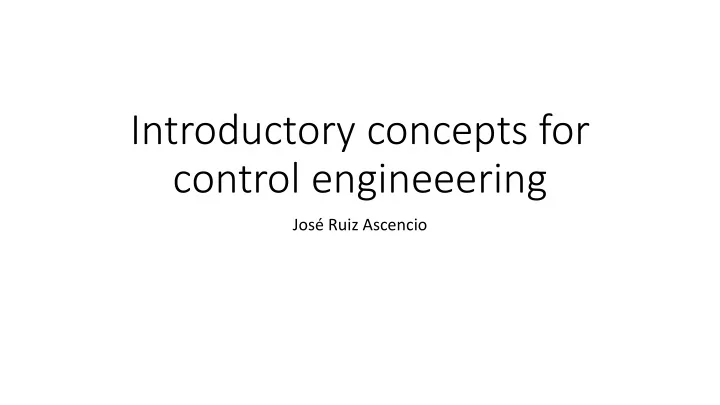

Introductory concepts for control engineeering José Ruiz Ascencio
Vocabulary • Input u(t) • Plant H(s), G(s), dy/dt + a*y = u • Output y(t) • State x(t) • Feedback • Controller • Setpoint, reference, command •
Subproblems of control Main problems are • Modelling and Controlling But there are • Stability • Simulation • Estimation • Identification • Simplification/Order reduction • Control goals GD
Benefits of feedback • A system with feedback will be robust : • Behavior will depend less on the plant and more on the feedback and the controller • Feedback can be used to give the system a reference model • Specified dynamics, different from those of the plant • E.g. making it behave like a second order system, when the plant is actually of higher order • Linear, when the plant is not. • CONTINUE w-GD-28
Recap • Modelling • First principles by means of ODE’s , physics. • Identification • Transient (e.g step) response. ⅆ𝑧 • Frequency response ⅆ𝑢 + 𝑏𝑧 = 𝑣 • Simulation (3-step) of an ODE in Simulink (or other) • Experimental • Requires collecting data, plus some theory • Today • Data driven modelling through the state evolution function
Simulink simulations of PID control
Example1: Open loop plant, no load
Example1: Open loop w/gain, when load appears
Signal traces • Yellow Setpoint • Pink Output • Blue Load • Red Error • Green Control (plant input)
Example1: Bang-bang control
Example1: Proportional control, various Kp values
Example1: Proportional control, Kp = 60, 120
Example1: From P to PD control. Dampened with Kd?
Example1: PD Control, Kp = 120, Kd = 12, 24 This “ anticipation ” effect is not a good idea, and the overshoot is worse …
Example1: PID control
Long-tem control behaviour, Proportional (Green) vs Integral (Red) components
Data driven modelling and control • Since all the signals that appear are functions of time, • e.g. u(t), y(t), x(t), we will drop the (t), excepto where necessary to make a point. • Let’s (=*equating objects of different nature) • y [t1, t2] =* y(t), t ϵ [t1, t2] • For a deterministic and causal system • y [t1, t2] = F{x(t1), y [t1, t2] } • y(t1) = f(x(t1), u(t1))
Data driven modelling and control • The state evolution function • x(t2) = φ [x(t1), u [t1, t2) ] for a time invariant system • x(t + T) = φ[x(t), u [t, t+T) ] sampled uniformly at T. • Key simplification: admit only staircase inputs: • u [t1, t2) =* u(t1) • That is the way computers work, so it is not a limitation.
Approximation of state evolution function • We use Nomura’s algorithm, but backpropagation neural network or ANFIS (neurofuzzy algorithm) or any Arbitrary Function Approximator in N dimensions will give the same result. • Although Nomura’s algorithm is slower, this implementation is very good for teaching purposes. H. Nomura, I. Hayashi, N. Wakami, A learning method of fuzzy inference rules by descent method, IEEE International Conference on Fuzzy Systems. San Diego, CA, USA, 8-12 March 1992.
Data acquisition • Inputs are “ staircased ” ( sampled with zero-order hold) • Outputs are sampled synchronously for acquisition • Antecedents are delayed to correspond with consequents
First-order data samples of system t u(t) x(t) x(t + T)
First-order samples and tuned surface: Input is not rich enough
Samples are more dispersed, will give better tunng. They are not confined to the plane, which means order is greater than one.
Test fuzzy model with a different input, no random component (for clarity), compare against original system.
Modelling via approximation of the state evolution function • The first-order fuzzy model approximates the plant reasonably well, even though: • The system order is (approximately) two (plus a small delay). • Tha samples are not well distributed • When we tune a second or greater -order model, it is imposible to plot the surface, so we have to trust the tuning error as an indicator.
Recommend
More recommend